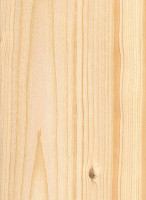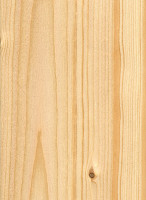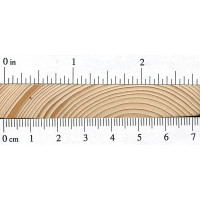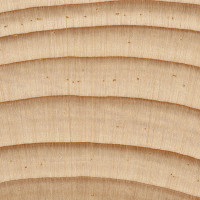 |
Common Name(s): Red Spruce, Adirondack Spruce Scientific Name: Picea rubens Distribution: Eastern North America Tree Size: 80-110 ft (24-34 m) tall, 2-4.5 ft (.6-1.4 m) trunk diameter Average Dried Weight: 27 lbs/ft3 (435 kg/m3) Specific Gravity (Basic, 12% MC): .37, .43 Janka Hardness: 490 lbf (2,180 N) Modulus of Rupture: 9,580 lbf/in2 (66.0 MPa) Elastic Modulus: 1,560,000 lbf/in2 (10.76 GPa) Crushing Strength: 4,870 lbf/in2 (33.6 MPa) Shrinkage: Radial: 3.8%, Tangential: 7.8%, Volumetric: 11.8%, T/R Ratio: 2.1 |
Color/Appearance: Red Spruce is typically a creamy white, with a hint of yellow and/or red.
Grain/Texture: Red Spruce has a fine, even texture, and a consistently straight grain.
Rot Resistance: Heartwood is rated as being slightly resistant to non-resistant to decay.
Workability: Easy to work, as long as there are no knots present. Glues and finishes well, though it can give poor (blotchy and inconsistent) results when being stained due to its closed pore structure. A sanding sealer, gel stain, or toner is recommended when coloring Spruce.
Odor: No characteristic odor.
Allergies/Toxicity: Although severe reactions are quite uncommon, Spruce in the Picea genus has been reported as a sensitizer. Usually most common reactions simply include skin irritation and/or respiratory disorders. See the articles Wood Allergies and Toxicity and Wood Dust Safety for more information.
Pricing/Availability: Construction grade spruce is cheap and easy to find. However, quartersawn clear pieces—free from knots—are much more expensive. Quartersawn billets of instrument-grade Red (Adirondack) Spruce can easily exceed the cost of most all domestic hardwoods in terms of per board-foot cost.
Sustainability: This wood species is not listed in the CITES Appendices, and is reported by the IUCN as being a species of least concern.
Common Uses: Paper (pulpwood), construction lumber, millwork, crates, Christmas trees, and musical instrument soundboards.
Comments: Red Spruce compares very similarly with Sitka Spruce in terms of mechanical properties, with the two species having nearly identical values.
 |
 |
 |
 |


Picea Ruben’s is called Red Spruce mainly because the first year growth of the needles are a red color. Also the male flowers and the cones are also reddish.
It has nothing to do with the wood color.
In fact it was called “yellow spruce” in the 19th century as a description of the color of the wood.
I may have pulled a red spruce sinker log out of Schroon lake and am wondering how to is the wood. This log still has the cutters stamp in both ends of the log. Thanks
This could be of great interest to luthiers (perhaps).Roger Siminoff would be a good person to talk to, although he has now retired from full-time luthier supplies. He refers to sbmerged maple in his publications. Spruce might not be enhanced in quite the same way. Also try contacting the “mandolin cafe” for luthier interest. Regards, Jon. (England).
I was looking for a aromatic spruce , I work as a carpenter and some wood well it looks like it’s Red Spruce . You’re comments say no odor? I think the White Spruce is almost odorless though some smell bad
Odorless until you cut it, that is. Spruce can have a pine-like scent. Red spruce wood isn’t red at all. It gets its name from the color of its twigs I believe. Red pine, if it’s heartwood, or even old white pine could be reddish. Aromatic woods are often called “cedar,” sometimes “cypress,” but could be from some other genus technically. Thuja, for example, gives us the Northern white and Western red-cedars, two strong smelling softwoods. No spruces are particularly aromatic. The scent of pine can sometimes be powerful like turpentine. Douglas fir has its own smell. True firs can… Read more »